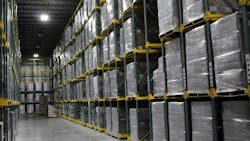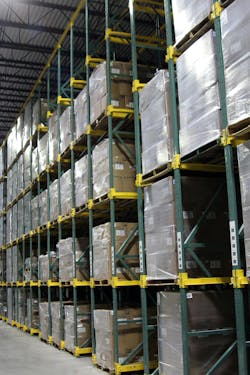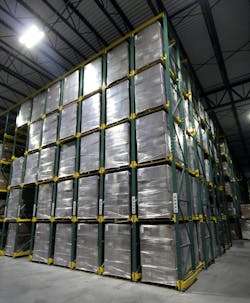How to keep up with rising cold storage requirements
In the cold and frozen food sector, tremendous growth combined with a serious shortage of capacity is severely constraining companies today. “The frozen food market is currently experiencing remarkable growth, with its global value soaring to $265 billion. In the U.S. alone, new frozen food sales have impressively surpassed the $72 billion mark,” stated Rick Kingery in the Colliers article “Capitalizing on the $265 Billion Frozen Food Market: Cold Storage’s Crucial Role.”
Experts also expect the U.S. will need an additional 100 million sq. ft. of cold storage space in the coming years to keep up.
For cold and frozen storage professionals, one solution to this dilemma might be looking at the racking and storage systems currently in place in their facilities. Depending on the age of the facility, there are several ways to increase storage density. This includes space-efficient racking systems along with advanced technology like pallet shuttles, which semi-automates high-density storage with specialized carts to facilitate the seamless movement of pallets within the storage framework.
Automating cold storage
At the forefront of this combination of rack and technology design are industry-leading OEMs that are offering enhanced warehouse efficiency and storage capabilities to meet the market’s urgent need for cold and frozen storage.
For businesses seeking optimal warehouse management in the cold and frozen storage market, for example, Steel King Industries, an OEM with expertise in designing and manufacturing pallet rack systems, offers a semi-automated pallet shuttle technology as a turnkey solution. The pallet shuttle is a lithium-ion powered Pallet Runner deep lane storage system from Automha Americas, a pioneering pallet shuttle provider, that efficiently moves pallets in and out of high-density storage lanes, creating increased storage density in an existing space.
The system is particularly suited to applications with high-volume SKUs, as pallets are loaded into the system by lift truck and transported into deep lanes by the Pallet Runner cart. Once the load is positioned, the cart returns to the front of the system to receive the next pallet. The lift truck operator travels only between load source and lane entry, and the cart does the rest. This maximizes productivity and minimizes travel distance for both product loading and unloading.
The Pallet Runner is a cost-effective option for companies looking to streamline their storage processes, reduce operational costs, and ensure a competitive edge in the rapidly evolving market. The deep lanes of the system increase storage density by reducing aisles and utilizing depth space, maximizing storage capacity within the same footprint. The system moves quickly and seamlessly, enhancing efficiency, expediting pallet loading/unloading, and reducing wait time for trucks at loading docks compared to traditional forklift operations. The systems can be scaled up or reconfigured with relative ease to accommodate growth or changes in product lines. With less need for forklift drivers to enter storage lanes, the Pallet Runner system reduces labor requirements and associated expenses while improving safety.
“The seamless integration of the pallet shuttle technology with the pallet rack systems will offer warehouses and distribution centers increased automation, efficiency, flexibility, productivity, and safety” said Don Heemstra, VP of sales and marketing for Steel King.
Selecting and optimizing cold storage racking
With costs per square foot for a cold storage facility up to three times that of a regular warehouse, choosing the right system is essential for efficiency and cost-effectiveness. Toward this effort, racking OEMs offer multiple types of cold storage pallet racking solutions including drive-in, pushback, pallet flow, and selective.
Selective racking is the most common type of pallet storage and allows easy and immediate access to any pallet as storage is only one pallet deep. Selective racking can also be used for double deep storage, stacking pallets two-deep accessible via reach truck.
However, drive-in racking is often the choice for cooler and freezer facilities, as these systems can accommodate up to 75% more pallets than selective racking. High-density storage is provided by allowing pallets to be stored multiple positions deep, which reduces the space needed for aisles and makes the rack a popular choice.
For example, food industry provider Coloma Frozen Foods was outsourcing its frozen storage to commercial facilities spread over a 20-mile radius from their location and among four inter-company locations for production, frozen storage, and repacking—a costly, inefficient process.
Looking to maximize frozen storage efficiency and repacking capability, the company consolidated its frozen storage capacity into a new 90,000-sq.-ft. freezer space that included 75,000 sq. ft. of racked freezer space utilizing drive-in racking.
With the drive-in rack, Coloma was able to store up to 75% more pallets than selective racking in the same space and expected to save about $150,000 to $200,000 a year in reduced labor, management, transportation, energy, and maintenance costs.
In an additional example, to meet retailer demand for efficient cold chain distribution, Manfredi Cold Storage expanded its Kennett Square, Pennsylvania, facility and installed a rugged drive-in rack. The racking is especially designed for high-traffic and cold temperature cooler/freezer installations.
The distributor handles fruit, vegetables, and food stuffs from 22 countries in a blast freezer environment in its 400,000-sq.-ft. facility. Steel King’s drive-in rack allowed Manfredi to move 25,000 pallets in 150-200 truckloads daily to supply grocery stores, club stores, distribution centers, and the food service industry quickly and efficiently.
Another option utilized by leading food companies to optimize cold storage capacity and longevity includes pushback racking systems that accommodate multiple-depth pallet storage, commonly two to five deep. In these systems, access to the pallets can be on one or both sides of the racking system. Because of the depth options, pushback racking can hold up to 90% more storage than a selective system. Pallets are loaded onto wheeled carts at each level of the racking. Inclined rails allow pallets to roll to the front of the rack as the most forward pallet is removed.
Pallet-flow racking systems, like pushback systems, take advantage of gravity to ensure that pallets are easily accessible from the front of the racking. But in these high-density, labor-saving systems, pallets are loaded on one side and unloaded on the other, assuring first-in, first-out (FIFO) handling. Forklifts are required only for the initial loading and final unloading.
Structural integrity considerations for cold room storage racks
In cooler and freezer applications, the rack must withstand some of the greatest forklift abuse in warehouse material handling due to the confined space, slick surfaces, and cold temperatures that slow driver reflexes and make impact more frequent. This can compromise the structural integrity of racking systems.
To prevent rack damage, Heemstra recommends using hot-rolled steel to manufacture the uprights and beams of structural steel racking. Horizontal and diagonal bracing and heavy-duty foot protectors can further enhance the durability of the racking in cold environments.
As one example in the industry, for greater overall strength and rigidity Heemstra recommends a pallet racking manufactured from high C-channel structural steel and ideal for use in a cold storage racking system. A heavy-duty lower horizontal brace and welded foot protector safeguard these areas that are prone to forklift damage. Since the system is modular, it can be designed to easily accommodate changing or expanding storage needs in cold storage facilities.
While such construction creates a higher up-front cost for structural storage racks, that can be more than offset by lower maintenance costs, greater safety for people working in the facilities, increased load capacities, and resistance to seismic forces.
As the cold and frozen food industry seeks greater storage space, efficiency, and longevity, companies that utilize best practice racking and technology along with expert guidance will position themselves for higher profits today and over the long term.
Del Williams is a technical writer based in Torrance, California.
About the Author
Del Williams
Del Williams is a technical writer based in Torrance, California.


